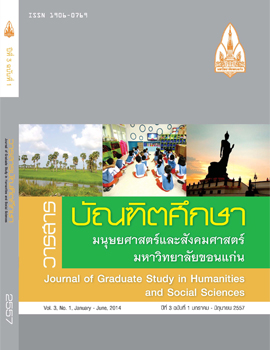รูปแบบการพัฒนาพระสังฆาธิการเพื่อประสิทธิภาพการบริหารกิจการคณะสงฆ์
คำสำคัญ:
พระสังฆาธิการ, การพัฒนาทรัพยากรมนุษย์, การบริหารกิจการคณะสงฆ์, Sangha Administrators, Human Resource Development, Sangha Administrationบทคัดย่อ
การวิจัยครั้งนี้มีวัตถุประสงค์ 1) เพื่อศึกษาการพัฒนาทรัพยากรมนุษย์ตามแนวทั่วไปและตามแนวพระพุทธศาสนา 2) เพื่อศึกษาสภาพการพัฒนาพระสังฆาธิการในการบริหารกิจการคณะสงฆ์ไทยในปัจจุบัน และ 3) เพื่อกำหนดรูปแบบการพัฒนาพระสังฆาธิการเพื่อประสิทธิภาพการบริหารกิจการคณะสงฆ์ ซึ่งเป็นการศึกษาเชิงเอกสารและการสัมภาษณ์แบบเจาะลึก กับผู้ให้ข้อมูลสำคัญ (Key Informant) ผลการวิจัยพบว่า การพัฒนาทรัพยากรมนุษย์ตามแนวทั่วไป เป็นการพัฒนาทรัพยากรมนุษย์ที่สำคัญ 4 ประการ (VETS) คือ 1) การสร้างวิสัยทัศน์ (Vision) 2) การศึกษา (Education) 3) การอบรม (Training) และ 4) การดูงาน (Study Tour) ส่วนการพัฒนาทรัพยากรมนุษย์ตามแนวพระพุทธศาสนาในการวิจัยครั้งนี้ ได้แก่ สิกขา 3 พรหมวิหาร 4 สังคหวัตถุ 4 ภาวนา 4 อิทธิบาท 4 และสัปปุริสธรรม 7 ส่วนรูปแบบการพัฒนาพระสังฆาธิการตามแนวทั่วไปและตามแนวพระพุทธศาสนา ที่จะให้มีประสิทธิภาพในการบริหารกิจการคณะสงฆ์ทั้ง 6 ด้าน ควรมีการบูรณาการการพัฒนาพระสังฆาธิการ ตามแนวทั่วไปและพระพุทธศาสนาเพื่อให้เกิดประสิทธิภาพในการบริหารกิจการคณะสงฆ์มากยิ่งขึ้น ได้แก่ 1) ด้านการปกครอง ควรบูรณาการการพัฒนาทรัพยากรมนุษย์ตามแนวทั่วไป (VETS) ร่วมกับหลักธรรม คือ พรหมวิหาร 4 ที่ถือว่าเป็นหลักธรรมที่เหมาะสมกับผู้ปกครองมากที่สุด 2) ด้านการศาสนศึกษา ควรบูรณาการการพัฒนาทรัพยากรมนุษย์ตามแนวทั่วไป (VETS) ร่วมกับหลักธรรม คือ สิกขา 3 ที่ถือว่าเป็นหลักธรรมในการพัฒนามนุษย์ให้เป็นผู้อยู่อย่างประเสริฐ 3) ด้านการศึกษาสงเคราะห์ ควรบูรณาการ การพัฒนาทรัพยากรมนุษย์ตามแนวทั่วไป (VETS) ร่วมกับหลักธรรม คือ สังคหวัตถุ 4 ที่ถือว่าเป็นหลักธรรม ที่เป็นเครื่องยึดเหนี่ยวจิตใจบุคคล และประสานหมู่ชนไว้ให้สามัคคี เป็นหลักการสงเคราะห์ซึ่งกันและกัน 4) ด้านการเผยแผ่ ควรบูรณาการการพัฒนาทรัพยากรมนุษย์ตามแนวทั่วไป (VETS) ร่วมกับหลักธรรม คือ ภาวนา 4 ที่ถือว่าเป็นหลักธรรมสำหรับพัฒนา ฝึกฝน อบรมมนุษย์ให้มีความสามารถดำรงชีวิตอยู่ในสังคมได้อย่างปกติสุข 5) ด้านการสาธารณูปการ ควรบูรณาการการพัฒนาทรัพยากรมนุษย์ตามแนวทั่วไป (VETS) ร่วมกับหลักธรรม คือ อิทธิบาท 4 ที่ถือว่าเป็นหลักธรรมที่ทำให้ประสบความสำเร็จ 6) ด้านสาธารณสงเคราะห์ ควรบูรณาการการพัฒนาทรัพยากรมนุษย์ตามแนวทั่วไป (VETS) ร่วมกับหลักธรรม คือ สัปปุริสธรรม 7 ที่ถือว่าเป็นหลักธรรมที่สามารถพัฒนามนุษย์ได้เป็นอย่างดี และด้วยการประยุกต์หลักการพัฒนาทรัพยากรมนุษย์ตามแนวทั่วไป (VETS) และหลักธรรม แต่ละหัวข้อสามารถยังการบริหารกิจการคณะสงฆ์ของพระสังฆาธิการได้อย่างมีประสิทธิภาพสูงสุด
Pattern of Human Resource Development of Sangha Administrators for Efficiency of Sangha Administration
The objectives of this research are: (1) to study the development of human resources, along with general and Buddhism. (2) to study the development status of Buddhist monks in the administration of the Sangha the present in Thailand and (3) to shape the development patterns of Buddhist monks for efficiency of Sangha administration. This study is a documentary research being interviewed with the key informants.Findings of this research are as follows: In the frame of general of human resource development, variables are interpreted into the conclusion as (1) vision, (2) education, (3) training and (4) study tour: while the development according to Buddhism is focused on the Threefold Training, the Four holy abiding, the Four bases of sympathy, the Four Mental Developments the Four Paths of Accomplishment, and the Seven qualities of a good man. The pattern of the Sangha development according to international and Buddhism to the full efficiency for the six sides of Sangha administration should be integrated the best means for Sangha administration as following, (1) Sangha governance the international VETS theory of human resource development and the Four Holy Abiding be applied; (2) Religious Education, human resource development for this division should be performed by integrating VETS with Ti Sikkha, threefold education, which is the most suitable Dhamma for human development to the sublime state of being. (3) Buddhist supporting education-the VETS theory and the Four bases of sympathy be applicable as the means of virtues making for group integration and leadership; (4) Buddhist propagation- there should be integrated of international VETS theory and the Four Training to the Sangha administration for this particular; (5) Construction and repair – the international VETS theory and the Four bases of accomplish meet be integrated and applied and (6) Public welfare – International VETS theory and the Four qualities of a good man be integrated by means and practice of the international VETS theory of human resource development in preclude with Buddhist doctrines as mentioned in each category can make the Sangha administration for all the six sides to the frill extent.







